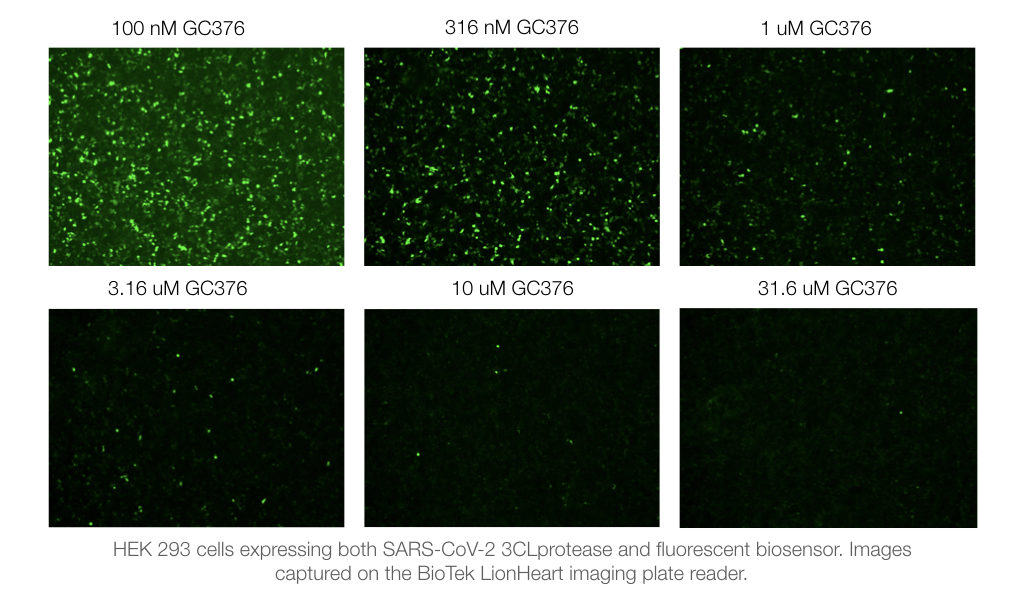Feline Infectious Peritonitis (FIP) is caused by a coronavirus. The 3CLpro of this virus is much like the one in SARS-CoV-2 and is crucial for viral replication. In 2016, Kim and colleagues showed that the compound GC376 blocked viral replication in cats destined to otherwise die (Kim et al. 2016). More recently, there have been exciting reports that this inhibitor also blocks the human 3CLpro found in SARS-CoV-2. We used a 3CL protease biosensor (3CLglow) to monitor GC376 inhibition in living HEK293 cells. 
3CLglow: An assay for 3CLpro/Mpro inhibitors
The 3CL protease of SARS-CoV-2, also known as “Main protease” is crucial to viral replication. Drugs that specifically inhibit this enzyme have enormous potential as therapeutics. The structure of the enzyme has been well characterized (Jin et al. 2020; Kneller et al. 2020) making it possible to screen for potential inhibitors in silico through docking (Jo et al. 2020; Sang et al. 2020; Hung et al. 2020; Gordon et al. 2020; Mukherjee et al. 2011; Choudhary et al. 2020).
High throughput assays for 3CLpro inhibitors that rely upon recombinant, purified enzyme and fluorescent substrates can be used to either test compounds identified with in silico screening, or to screen libraries of new compounds. However, these biochemical assays lack cellular context and biological relevance (Vincent et al. 2015). In contrast, 3CLglow reports activity in living cells and captures physiologically relevant dose response information.
The 3CLglow assay can validate hits from biochemical assays, or it can be used in automated primary screening. 3CLglow identifies inhibitors that can enter living cells, block the 3CLpro enzyme (even in a subcellular compartment) without killing the cells, providing an important bridge between biochemistry and animal models. The observation that GC376, a drug that saves cats lives, inhibits SARS-CoV-2 3CL protease is fortuitous as it provides a reliable control for the 3CLglow assay.
Assay Kit
Protocol
Contact us
References
Chen, Lili, Shuai Chen, Chunshan Gui, Jianhua Shen, Xu Shen, and Hualiang Jiang. 2006. “Discovering Severe Acute Respiratory Syndrome Coronavirus 3CL Protease Inhibitors: Virtual Screening, Surface Plasmon Resonance, and Fluorescence Resonance Energy Transfer Assays.” Journal of Biomolecular Screening 11 (8): 915–21.
Choudhary, M. Iqbal, Muniza Shaikh, Atia- Tul-Wahab, and Atta- Ur-Rahman. 2020. “In Silico Identification of Potential Inhibitors of Key SARS-CoV-2 3CL Hydrolase (Mpro) via Molecular Docking, MMGBSA Predictive Binding Energy Calculations, and Molecular Dynamics Simulation.” PloS One 15 (7): e0235030.
Fu, Lifeng, Fei Ye, Yong Feng, Feng Yu, Qisheng Wang, Yan Wu, Cheng Zhao, et al. 2020. “Both Boceprevir and GC376 Efficaciously Inhibit SARS-CoV-2 by Targeting Its Main Protease.” Nature Communications 11 (1): 4417.
Gordon, David E., Gwendolyn M. Jang, Mehdi Bouhaddou, Jiewei Xu, Kirsten Obernier, Kris M. White, Matthew J. O’Meara, et al. 2020. “A SARS-CoV-2 Protein Interaction Map Reveals Targets for Drug Repurposing.” Nature 583 (7816): 459–68.
Hung, Hui-Chen, Yi-Yu Ke, Sheng Yu Huang, Peng-Nien Huang, Yu-An Kung, Teng-Yuan Chang, Kuei-Jung Yen, et al. 2020. “Discovery of M Protease Inhibitors Encoded by SARS-CoV-2.” Antimicrobial Agents and Chemotherapy, July. https://doi.org/10.1128/AAC.00872-20.
Jin, Zhenming, Xiaoyu Du, Yechun Xu, Yongqiang Deng, Meiqin Liu, Yao Zhao, Bing Zhang, et al. 2020. “Structure of Mpro from SARS-CoV-2 and Discovery of Its Inhibitors.” Nature 582 (7811): 289–93.
Jo, Seri, Suwon Kim, Dong Hae Shin, and Mi-Sun Kim. 2020. “Inhibition of SARS-CoV 3CL Protease by Flavonoids.” Journal of Enzyme Inhibition and Medicinal Chemistry 35 (1): 145–51.
Kim, Yunjeong, Hongwei Liu, Anushka C. Galasiti Kankanamalage, Sahani Weerasekara, Duy H. Hua, William C. Groutas, Kyeong-Ok Chang, and Niels C. Pedersen. 2016. “Reversal of the Progression of Fatal Coronavirus Infection in Cats by a Broad-Spectrum Coronavirus Protease Inhibitor.” PLoS Pathogens 12 (3): e1005531.
Kneller, Daniel W., Gwyndalyn Phillips, Hugh M. O’Neill, Robert Jedrzejczak, Lucy Stols, Paul Langan, Andrzej Joachimiak, Leighton Coates, and Andrey Kovalevsky. 2020. “Structural Plasticity of SARS-CoV-2 3CL Mpro Active Site Cavity Revealed by Room Temperature X-Ray Crystallography.” Nature Communications 11 (1): 3202.
Mukherjee, Prasenjit, Falgun Shah, Prashant Desai, and Mitchell Avery. 2011. “Inhibitors of SARS-3CLpro: Virtual Screening, Biological Evaluation, and Molecular Dynamics Simulation Studies.” Journal of Chemical Information and Modeling 51 (6): 1376–92.
Sang, Peng, Shuhui Tian, Zhaohui Meng, and Liquan Yang. 2020. “Insight Derived from Molecular Docking and Molecular Dynamics Simulations into the Binding Interactions between HIV-1 Protease Inhibitors and SARS-CoV-2 3CLpro.” ChemRxiv. https://doi.org/10.26434/chemrxiv.11932995.v1.
Vincent, Fabien, Paula Loria, Marko Pregel, Robert Stanton, Linda Kitching, Karl Nocka, Regis Doyonnas, et al. 2015. “Developing Predictive Assays: The Phenotypic Screening ‘rule of 3.’” Science Translational Medicine 7 (293): 293ps15–293ps15.
Vuong, Wayne, Muhammad Bashir Khan, Conrad Fischer, Elena Arutyunova, Tess Lamer, Justin Shields, Holly A. Saffran, et al. n.d. “Feline Coronavirus Drug Inhibits the Main Protease of SARS-CoV-and Blocks Virus Replication.” https://doi.org/10.1101/2020.05.03.073080.
Zhu, Wei, Miao Xu, Catherine Z. Chen, Hui Guo, Min Shen, Xin Hu, Paul Shinn, Carleen Klumpp-Thomas, Samuel G. Michael, and Wei Zheng. 2020. “Identification of SARS-CoV-2 3CL Protease Inhibitors by a Quantitative High-Throughput Screening.” bioRxiv. bioRxiv. https://doi.org/10.1101/2020.07.17.207019.



